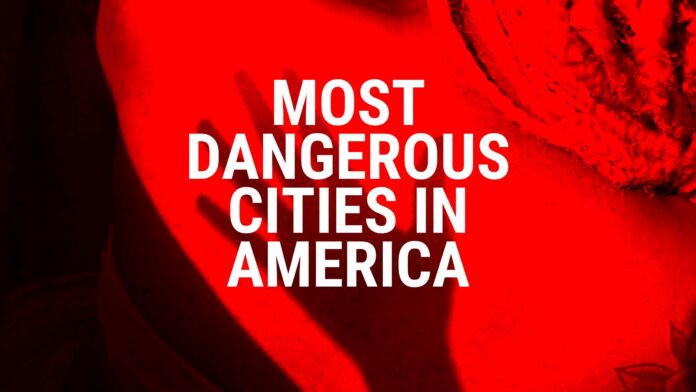When considering a place to live, work, or raise a family, safety is one of the top priorities. The United States, while home to some of the world’s most desirable cities, also has areas plagued by high crime rates. In this article, we explore the most dangerous cities in America for the years 2025 to 2026, based on violent and property crime statistics reported by the FBI.
Crime statistics, particularly rates of violent crimes such as homicide, aggravated assault, and robbery, play a significant role in determining the overall safety of a city. Property crimes, including burglary and car theft, also contribute to a city’s danger level. Here, we highlight the top 10 dangerous cities in the US, delving into the factors that contribute to their rankings.
1. Memphis, Tennessee
Where is the most dangerous city in America? For 2025–2026, Memphis ranks #1.
- Population: 633,533
- Median Home Value: $226,459
- Median Monthly Rent: $839
- Median Household Income: $53,366
- Average Commute: 20 minutes
Why Memphis?
Memphis has consistently ranked among the most violent cities in the US. High rates of gun violence, gang-related activity, and aggravated assaults plague the city. The murder rate per 100,000 residents is one of the highest in the country, placing Memphis at the top of the most dangerous cities in America list.
Despite efforts from community programs and law enforcement, the city struggles with economic disparity and low education levels, which are contributing factors to its crime issues.
2. Oakland, Californiat
- Population: 433,476
- Median Home Value: $1,003,425
- Median Monthly Rent: $1,812
- Median Household Income: $99,318
- Average Commute: 27 minutes
A Tale of Two Cities
Oakland’s vibrant arts and tech scene contrasts starkly with its issues of violent crime. The city is among the most unsafe cities in the US, with a high incidence of armed robberies, assaults, and homicides. Socioeconomic disparities, coupled with homelessness and drug abuse, have made Oakland a regular feature among the top dangerous cities in the US.
3. St. Louis, Missouri
- Population: 282,985
- Median Home Value: $197,774
- Median Monthly Rent: $750
- Median Household Income: $56,226
- Average Commute: 21 minutes
Consistently Among the Most Dangerous
St. Louis frequently ranks among the most ghetto cities in America due to high poverty and unemployment rates. It has one of the highest murder rates in the US, often surpassing larger cities in sheer numbers of homicides per capita.
While efforts have been made to revitalize downtown areas and improve community policing, crime persists, particularly in North St. Louis.
4. Baltimore, Maryland
- Population: 568,184
- Median Home Value: $210,666
- Median Monthly Rent: $1,045
- Median Household Income: $58,427
- Average Commute: 23 minutes
Chronic Urban Challenges
Baltimore has long been a fixture on the most dangerous cities lists. The city deals with drug-related crime, gang violence, and a declining trust in law enforcement following multiple high-profile incidents. It’s often cited in discussions around what cities in America have the highest crime rate.
The city’s challenges are compounded by systemic issues in housing, education, and healthcare.
5. Detroit, Michigan
- Population: 663,149
- Median Home Value: $101,664
- Median Monthly Rent: $774
- Median Household Income: $40,745
- Average Commute: 22 minutes
Once a Powerhouse, Now a Cautionary Tale
Detroit’s decline following the collapse of the auto industry left it with high unemployment, poverty, and crime. Despite recent revitalization efforts in the downtown area, many neighborhoods remain among the deadliest cities in the US.
Gun violence, drug trafficking, and theft are widespread, and the city’s infrastructure continues to deteriorate.
6. Alexandria, Louisiana
- Population: 44,264
- Median Home Value: $190,140
- Median Monthly Rent: $642
- Median Household Income: $49,052
- Average Commute: 14 minutes
Small City, Big Problems
Despite its size, Alexandria faces crime rates comparable to larger urban areas. With limited resources for law enforcement and public services, the city has become one of the top 10 dangerous cities in US. Violent crime, particularly domestic violence and shootings, remains a pressing issue.
7. Cleveland, Ohio
- Population: 385,883
- Median Home Value: $118,959
- Median Monthly Rent: $762
- Median Household Income: $41,583
- Average Commute: 20 minutes
Persistent Urban Decline
Cleveland’s economic downturn over the years has had lasting effects. The city consistently ranks in lists of what cities have the highest crime rates in the US. Poverty and lack of educational opportunities have fueled a cycle of crime, particularly among youth.
8. New Orleans, Louisiana
- Population: 366,013
- Median Home Value: $306,358
- Median Monthly Rent: $915
- Median Household Income: $51,730
- Average Commute: 20 minutes
Tourist Magnet with a Dark Side
New Orleans draws millions of tourists, yet its residents face serious safety issues. High rates of violent crime, including homicides, place it among the most dangerous cities in America. Post-Katrina recovery has been slow in many neighborhoods, exacerbating social and economic divides.
9. Monroe, Louisiana
- Population: 46,789
- Median Home Value: $175,498
- Median Monthly Rent: $655
- Median Household Income: $38,279
- Average Commute: 16 minutes
A Community Under Strain
Monroe is a relatively small city but faces crime rates that rival some of the nation’s biggest metros. Low income, unemployment, and drug-related crimes contribute to Monroe’s high ranking among the most dangerous cities in America.
10. Pueblo, Colorado
- Population: 111,642
- Median Home Value: $281,840
- Median Monthly Rent: $869
- Median Household Income: $56,197
- Average Commute: 16 minutes
The Unexpected Entry
Pueblo may not be the first city that comes to mind when thinking about crime, but it has made the top 10 dangerous cities in America list due to a surge in gang activity, drug trafficking, and property crimes. Economic hardship continues to burden many neighborhoods.
Conclusion: The State of Urban Safety in America
The cities listed above represent some of the most violent cities in the US, with complex social, economic, and political factors contributing to their high crime rates. Whether it’s Memphis’s ongoing gang violence or Cleveland’s battle with poverty-driven crime, these cities reflect the urgent need for comprehensive urban reform.








